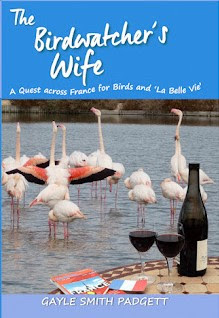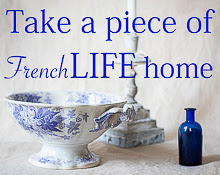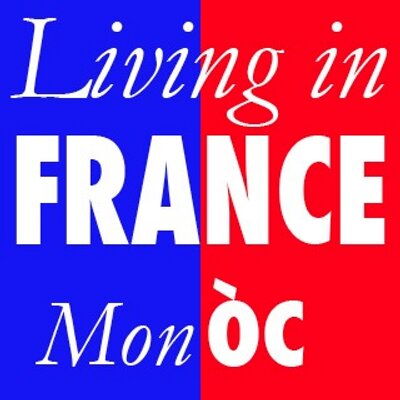Down on the Côte d’Azur, my friend Lanie Goodman wears way more than her share of hats. In addition to teaching part time at the SKEMA Business School at Sophia-Antipolis, she writes about travel, food, film, books, art, architecture and design for a wide range of top publications including the Wall Street Journal, Elle Décor, Interior Design and Conde Nast Traveller. Plus, she does translation—and has translated four contemporary novels from French into English.
Having lived in France for 24 years, Lanie has a very wide network, with personal and professional contacts in all the fields above. So when the UK-based publisher Cico Books was looking for someone to produce and write a book on romantic French home design, Lanie seemed a natural.
True to form, my gal pal hit the road running. Her first assignment was to actually find the properties that would be profiled and photographed…not such an easy task given that French homeowners tend to be quite private. But slowly and diligently, Lanie was able to gather a group of wonderful houses, to convince the owners to share their compelling stories and then encourage them to open their doors once again, so their homes and beautiful possessions could be photographed. She toured roughly 30 homes and eventually selected 14. “I knew immediately which were right,” she says. “We didn’t want decorated or ‘done up’ homes--it was more about an artfully assembled mix of different styles and an atmosphere that reflects the ‘soul’ of the owners. Often, the history of the walls were part of the story.”
In publishing terms, the project was a rush—it took just seven months--and the book came out last week. Go Lanie!
And, as I often do when I find a book I think you’ll love, I’ve asked the publisher for some copies for you to win. Graciously, Cico Books said yes to two copies. So if you’d like to win one, just leave a comment under “comments” at the end of this story. Meanwhile, here’s a bit more about the book…
The properties in Romantic French Homes are spread out across France, from the city streets of Paris to Megeve in the French Alps; from the windswept coast of Normandy to the heart of Provence and the sun-baked shores of the Riviera. There are classic country houses which have been in the same family for generations, tiny boltholes, city apartments, quirky seaside homes and more. Each home has its own very-individual character, reflecting the owners and their passions.
In Paris we get a glimpse of a sophisticated pied-a-terre owned by an acclaimed musician. In the Alps, we’re invited into a chalet built with reclaimed wood from surrounding old farmhouses. Another property is a grand château owned by Alexis de Tocqueville, filled with antiques collected by generations of the de Tocqueville family.
The book is divided into four chapters: Châteaux (castles, châteaux, grand country houses, and town houses); Bastides (old manors and farmhouses); Maisons Bohèmes (artist's, writer's and seaside homes); and Paysannes and Pavilions (small and simple, thrifty and humble town houses and country houses). Whether grand and imposing or humble and rustic, the authentic charm and history of these houses shines through.
One of Lanie’s most serendiptous finds was in St. Tropez, while trying to locate Colette's home, La Treille Muscate. The writer had lived just outside the village for many years…before Bardot…before it was fashionable. ‘’I knew where it was on the map,’’ Lanie recalls, ‘’so I parked my car and began walking towards the house, hoping to catch a glimpse of what I remembered from the photos. Obviously, most of the villas in St. Tropez today are hidden by high walls replete with intercoms and cameras, but I happened to stumble upon a very inviting property in passing--a little Provencal stone mas surrounded by an overgrown lush garden, a pool, and trees strung with paper lanterns. A gypsy caravan sat in one corner, a giant Indonesian day bed draped with beautiful fabrics by the pool. La bohème! The gate was wide open so I walked in. A lovely suntanned woman in bare feet and jeans came to greet me with a smile--I apologized for trespassing and asked if, by any chance, this was Colette's former home. She said 'It's just down the road. But this used to be Marcel Pagnol's house. Would you like to see it?’ You bet I did. And it’s one of my favorite homes in the book.”
The 176-page hardcover has 150 or so color photos by English photographer Simon Brown and can be found in bookshops and boutiques.
Ok! How to win a copy? Simply leave a comment below, by clicking the word ''comments,'' and you'll be entered into the giveaway. Please don’t forget to include your email address so we can reach you if you win; signing in with your Google account is not enough.
You can also buy the book on Amazon here (US) or here (UK).
If you’re in Nice on Thursday, March 28, be sure to pop by the Librairie Massena at #55, rue Gioffredo (tel 04 93 80 90 16). Lanie will be there from 6:30 pm onward, greeting friends, sharing stories and signing books.
To see all the current Cico Books titles, click here. To follow them on Twitter: @cicobooks
Photos: 1. One of the 14 houses in the book is the 18th-century-style bastide “Les Confines,” near St. Remy de Provence. The exterior was rendered more elegant by limewashing the facade, realigning and enlarging the windows and repainting the shutters in a natural shade of green that would harmonize with the garden. “The five magnificent plane trees and the underground source were a real draw,” says owner Dominique Lafourcade, an artist and landscape architect whose passion for gardens is reflected in the design of the bastide’s interiors as well. To replace an unsightly metal shed in front of the house, the owners dug out an oval pond, filled with water lilies and connected it to a long central ribbon of water, which serves as the geometric “spinal column” of the garden. Dominique is married to well-known architect Bruno Lafourcade, who runs his high-profile firm with his architect son, Alexandre. 2. The cheery country kitchen is the central hub of activity since the owners are passionate cooks. The antique wooden farm table, found locally, was given a Verona marble tabletop. For added color, the simple chairs, from a brocante market, were painted blue. The walls are decorated with Salernes ceramic tiles from Alain Vagh. 3. The cozy winter living room is a fanciful mix of trompe l’oeil murals, lamps, mirror frames and faux animal-skin chairs. 4. The dining room is a patchwork of color and whimsy, filled with local animal-themed bric à brac and garden flowers. Dominique's trompe l’oeil murals depict the couple’s favorite landscapes from their travels. 5. A view from the bastide terrace. The 20-acre property includes two swimming pools bordered by greenery, a flower and vegetable garden, a fruit orchard and a fanciful African garden hemmed in by bamboo with rare exotic plants. The smaller southwest-facing dining terrace faces a garden of clipped ornamental round hedges. “It’s the perfect spot to enjoy the last rays of light before sunset,” says Dominique.
Like this story? Subscribe to Provence Post here.




























































.jpg)





.jpg)





















